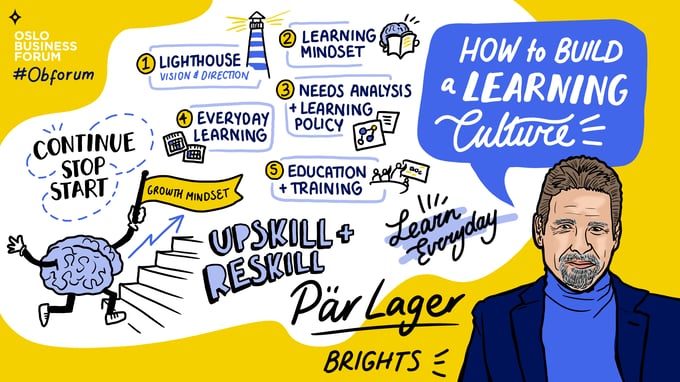Pär Lager is a senior advisor of executive education and lecturer at the Swedish Defence University. He specializes in leadership, change management, resilience, and creating a learning culture. He is the author of three leadership books, including "Upskill & Reskill," "The Principle of Change," and "Communicative Leadership."
At Oslo Business Forum, Par laid out five clear steps leaders can take to create a learning culture in their organizations.
The Need to Upskill & Reskill
In an environment where change is occurring at a rapid pace and our organizations are facing high demands, the need for learning is more important than ever. Lifelong learning has always been a worthy pursuit, but Pär believes preparing for the future requires a new approach: upskilling and reskilling.
As leaders consider what their professions and organizations will look like five, ten, and twenty years from now, they must think about the roles that will remain and how their level of complexity may change.
There are many roles that will remain in the future of work, but these jobs are likely to become more complex. This will require us to upskill, enhancing our knowledge and abilities to keep pace. There are many roles that new jobs will replace in the future of work, and those jobs may be low or high in complexity. This will require us to reskill, equipping ourselves with new knowledge and abilities.
While the roles that will emerge in the future of work are still unclear, leaders can be sure of one thing: equipping their teams to successfully upskill and reskill will require a learning culture.
5 Steps to Create a Learning Culture
In Pär's research and work with organizations, he has uncovered a common framework that creates a strong foundation for a culture of learning. He believes that the organizations that have successfully built a learning culture have five things in common:
- Have a clear lighthouse. Leaders who create a clear vision help everyone in the organization understand the direction they are headed—and what they need to learn to get there.
- Cultivate a learning mindset. Leaders who understand and embrace the increased need for learning today inspire greater growth in their teams.
- Conduct a needs analysis and establish a learning policy. Leaders who uncover what their teams need to learn instill learning best practices into their organizations.
- Encourage everyday learning. Leaders who encourage learning before, after, and on the job experience the greatest success.
- Create education and training programs. Leaders who create opportunities for in-depth learning through formal education programs and training see a learning culture take hold for the long term.
"Sometimes you can say that learning is the job, every day and every week."
.jpg?width=720&name=MaxEmanuelson_OsloBusinessForum_MAX09094%20(1).jpg)
Cultivate a Learning Mindset
Pär acknowledged that most organizations haven't navigated all five steps to solidify their learning culture foundation, but many have traveled at least part of the path. To continue on their journeys, Pär believes it's vital for leaders to adopt—and cultivate in their teams—a learning mindset.
Pär equates a learning mindset with a growth mindset, one that inspires continuous learning. He left leaders at Oslo Business Forum with four questions to help them cultivate a growth mindset:
- Why? Why do I want and need to learn?
- How and what? How do I learn best, and what should I learn?
- Where are the opportunities? Are you aware of the opportunities for learning inside and outside the organization?
- What are the habits? How can we build behaviors that allow us to learn every day?
Key Points
- As we consider the future of work, there will be a need for upskilling and reskilling.
- Roles that will remain in the future will likely become more complex. This will require us to upskill.
- There will be many roles replaced by new jobs in the future. This will require us to reskill.
- Organizations that have successfully built a learning culture have five things in common: 1) They have a clear lighthouse; 2) They have a learning mindset; 3) They have done a needs analysis and adopted a learning policy; 4) They encourage everyday learning; and 5) They have formal education and training programs.
Questions to Consider
- Do you foresee a future need for upskilling, reskilling, or both in your organization?
- Does your organization have a clear lighthouse? Does everyone understand where you're going and how to get there?
- Have you performed a needs analysis to understand what your teams need to learn and how they learn in the best way?
- As a leader, have you adopted a growth mindset? Have you taken steps to instill a learning mindset in your teams?

Want to be a part of the OBF community? Join Oslo Business Forum 2023: Thriving in Chaos now!.png?width=680&name=CTA_2023%20(2).png)